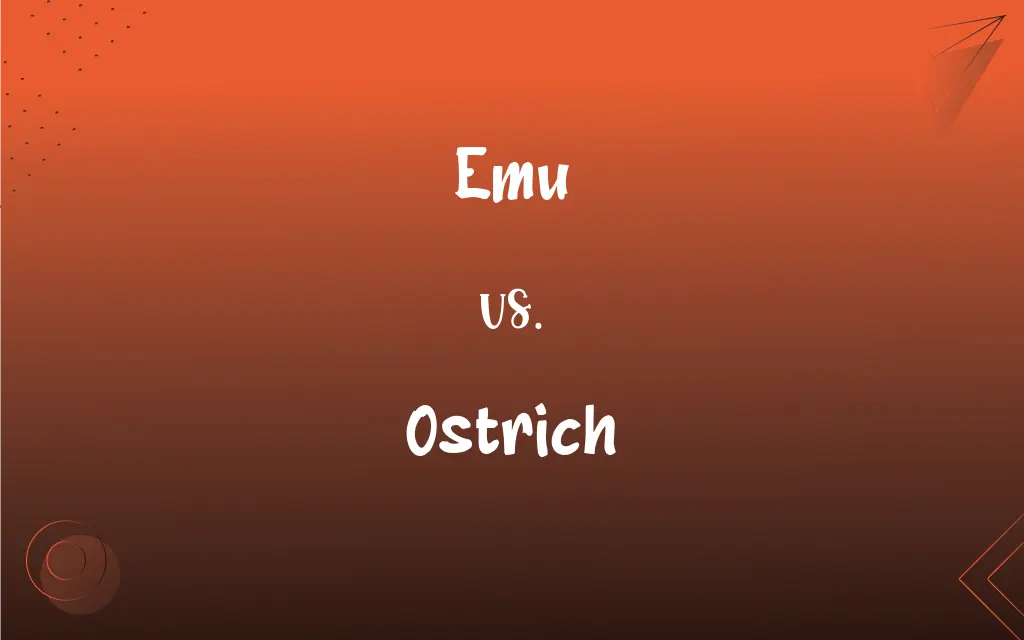Emu vs. Ostrich: What's the Difference?
Edited by Janet White || By Harlon Moss || Updated on October 3, 2023
Emu is a large flightless bird native to Australia, while an ostrich is its African counterpart, notable for being the world's largest bird.

Key Differences
Emus, found primarily in Australia, are the second-largest birds in the world. Ostriches, on the other hand, hold the title for the world's largest bird, residing mostly in Africa.
The emu's plumage is brown with a shaggy appearance, making them adept at blending into their native Australian landscape. Ostriches showcase a more distinct feather pattern, with males bearing black and white plumes, and females presenting grayish-brown hues.
Both emus and ostriches are flightless, relying instead on their strong legs for movement. While emus can reach speeds up to 30 mph, ostriches outpace them, clocking in at around 45 mph.
In terms of temperament, emus can be curious and relatively approachable, although caution is advised around wild individuals. Ostriches, however, are known to be more unpredictable, and their powerful kicks can be dangerous if they feel threatened.
Lastly, when comparing their sounds, emus make a deep drumming noise, almost akin to a low thumping. Ostriches, contrastingly, emit a variety of sounds from hissing to booming, often resonating like a lion's roar from afar.
ADVERTISEMENT
Comparison Chart
Origin
Australia
Africa
Size
Second largest bird
Largest bird
Speed
Up to 30 mph
Up to 45 mph
Temperament
Curious, approachable
Unpredictable, can be aggressive
Sound
Deep drumming
Hissing to booming
ADVERTISEMENT
Emu and Ostrich Definitions
Emu
A large, flightless bird native to Australia.
The emu is an iconic species of the Australian outback.
Ostrich
Capable of emitting a wide range of sounds, from hissing to booming.
At night, the booming call of the ostrich can be mistaken for a lion's roar.
Emu
Possesses a shaggy brown plumage.
The emu's brown feathers help camouflage it in the Australian brush.
Ostrich
Exhibits black and white plumage in males and grayish-brown in females.
The male ostrich's black and white feathers are especially vibrant during mating season.
Emu
Characterized by a deep, drumming sound.
From a distance, one can hear the distinctive drumming call of the emu.
Ostrich
Renowned for its ability to run at high speeds.
Despite its size, an ostrich can run faster than many animals.
Emu
Known for its strong legs and rapid running speed.
The emu can outrun many potential threats in the wild.
Ostrich
The world's largest bird, native to Africa.
The ostrich's impressive size makes it a popular sight on African safaris.
Emu
An avian symbol of Australia's unique wildlife.
Tourists often visit Australia hoping to spot an emu in the wild.
Ostrich
Recognized for its long neck and powerful legs.
An ostrich relies on its powerful legs for defense and speed.
Emu
A large, flightless Australian bird (Dromaius novaehollandiae) that has shaggy brown plumage and is raised for its meat, oil, and leather.
Ostrich
Either of two large, swift-running flightless birds (Struthio camelus or S. molybdophanes) of Africa, characterized by a long bare neck, small head, and two-toed feet. Ostriches are the largest living birds.
Emu
(obsolete) A cassowary (genus Casuarius).
Ostrich
A rhea.
Emu
A large flightless bird native to Australia, Dromaius novaehollandiae.
Ostrich
One who tries to avoid disagreeable situations by refusing to face them.
Emu
(physics) electromagnetic unit
Ostrich
(ornithology) A large flightless bird of the genus Struthio.
Emu
Clipping of emulator
Emu
A large Australian bird, of two species (Dromaius Novæ-Hollandiæ and D. irroratus), related to the cassowary and the ostrich. The emu runs swiftly, but is unable to fly.
Emu
Any of various systems of units for measuring electricity and magnetism
Emu
Large Australian flightless bird similar to the ostrich but smaller
FAQs
Are emus and ostriches related?
Yes, both are ratites, a group of large, flightless birds.
Do emus fly?
No, emus are flightless birds.
How do ostriches defend themselves?
They use their strong legs to kick and can also run away at high speeds.
Are emus good swimmers?
Yes, emus are surprisingly good swimmers and can cross water bodies when needed.
Are ostriches dangerous?
While generally not aggressive, they can be unpredictable and their kicks are powerful.
What's the lifespan of an emu?
Emus typically live for 10 to 20 years in the wild.
What's a group of ostriches called?
A group of ostriches is often referred to as a flock or a pride.
Which is bigger, an emu or an ostrich?
The ostrich is the larger of the two.
How fast can an ostrich run?
An ostrich can run up to 45 mph.
What do emus sound like?
Emus produce a deep drumming noise.
What do ostriches eat?
Ostriches are omnivores, eating plants, seeds, and small animals.
What is the purpose of the long neck of an ostrich?
It helps in spotting predators and also aids in thermoregulation.
How many toes does an ostrich have?
Ostriches have two toes on each foot.
What's the primary habitat of emus?
They are found in various habitats across Australia, from forests to grasslands.
What is an emu?
An emu is a large, flightless bird native to Australia.
How tall can emus get?
Emus can reach heights of around 6 feet.
Where can ostriches be found?
Ostriches are native to Africa.
What are emu eggs like?
Emu eggs are large, dark green, and have a thick shell.
Are emus social birds?
Yes, emus are often seen in pairs or small groups.
Is it true that ostriches bury their heads in the sand?
No, that's a myth. They might lower their heads to eat or rest, but they don't bury them.
About Author
Written by
Harlon MossHarlon is a seasoned quality moderator and accomplished content writer for Difference Wiki. An alumnus of the prestigious University of California, he earned his degree in Computer Science. Leveraging his academic background, Harlon brings a meticulous and informed perspective to his work, ensuring content accuracy and excellence.
Edited by
Janet WhiteJanet White has been an esteemed writer and blogger for Difference Wiki. Holding a Master's degree in Science and Medical Journalism from the prestigious Boston University, she has consistently demonstrated her expertise and passion for her field. When she's not immersed in her work, Janet relishes her time exercising, delving into a good book, and cherishing moments with friends and family.































































